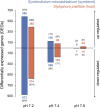New Insights From Transcriptomic Data Reveal Differential Effects of CO2 Acidification Stress on Photosynthesis of an Endosymbiotic Dinoflagellate in hospite
- PMID: 34349734
- PMCID: PMC8326563
- DOI: 10.3389/fmicb.2021.666510
New Insights From Transcriptomic Data Reveal Differential Effects of CO2 Acidification Stress on Photosynthesis of an Endosymbiotic Dinoflagellate in hospite
Abstract
Ocean acidification (OA) has both detrimental as well as beneficial effects on marine life; it negatively affects calcifiers while enhancing the productivity of photosynthetic organisms. To date, many studies have focused on the impacts of OA on calcification in reef-building corals, a process particularly susceptible to acidification. However, little is known about the effects of OA on their photosynthetic algal partners, with some studies suggesting potential benefits for symbiont productivity. Here, we investigated the transcriptomic response of the endosymbiont Symbiodinium microadriaticum (CCMP2467) in the Red Sea coral Stylophora pistillata subjected to different long-term (2 years) OA treatments (pH 8.0, 7.8, 7.4, 7.2). Transcriptomic analyses revealed that symbionts from corals under lower pH treatments responded to acidification by increasing the expression of genes related to photosynthesis and carbon-concentrating mechanisms. These processes were mostly up-regulated and associated metabolic pathways were significantly enriched, suggesting an overall positive effect of OA on the expression of photosynthesis-related genes. To test this conclusion on a physiological level, we analyzed the symbiont's photochemical performance across treatments. However, in contrast to the beneficial effects suggested by the observed gene expression changes, we found significant impairment of photosynthesis with increasing pCO2. Collectively, our data suggest that over-expression of photosynthesis-related genes is not a beneficial effect of OA but rather an acclimation response of the holobiont to different water chemistries. Our study highlights the complex effects of ocean acidification on these symbiotic organisms and the role of the host in determining symbiont productivity and performance.
Keywords: F’/Fm’; Symbiodiniaceae; carbon-concentrating mechanism; coral-dinoflagellate symbiosis; gene expression; ocean acidification; pCO2.
Copyright © 2021 Herrera, Liew, Venn, Tambutté, Zoccola, Tambutté, Cui and Aranda.
Conflict of interest statement
The authors declare that the research was conducted in the absence of any commercial or financial relationships that could be construed as a potential conflict of interest.
Figures






References
-
- Al-Moghrabi S., Goiran C., Allemand D., Speziale N., Jaubert J. (1996). Inorganic carbon uptake for photosynthesis by the symbiotic coral-dinoflagellate association II. Mechanisms for bicarbonate uptake. J. Exp. Mar. Biol. Ecol. 199 227–248. 10.1016/0022-0981(95)00202-2 - DOI
LinkOut - more resources
Full Text Sources

